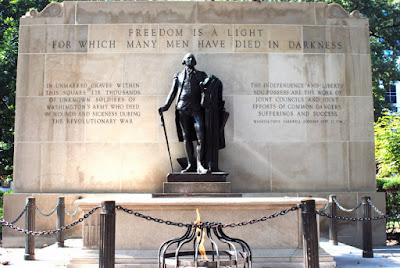
In Manhattan at the beginning of Fifth Avenue, on the north side of Washington Square Park, stands the Beaux Arts monument of Tuckahoe marble displaying two huge likenesses of George Washington, warrior, statesman, Freemason.
From mountvernon.org:
George Washington was born at his father’s plantation on Pope’s Creek in Westmoreland County, Virginia, on February 22, 1732. His father, Augustine Washington, was a leading planter in the area and also served as a justice of the county court. Augustine’s first wife, Janet Butler, died in 1729, leaving him with two sons, Lawrence and Augustine, Jr., and a daughter, Jane. The elder Augustine then married George’s mother, Mary Ball, in 1731. George was the eldest of Augustine Washington’s and Mary Ball’s six children.
In 1735 Augustine moved the family up the Potomac River to another Washington home, Little Hunting Creek Plantation (later renamed Mount Vernon). In 1738 they moved again to Ferry Farm, a plantation on the Rappahannock River near Fredericksburg, Virginia, where George spent much of his youth. Little is known of Washington’s childhood, and it remains the most poorly understood part of his life. Popular fables illustrating his youthful honesty, piety, and physical strength have long taken the place of documented fact. Some of these fables are more plausible than others. The story that Washington threw a silver dollar across the Potomac River – an impossible feat – had its origins in the recollections of a cousin that George could throw a stone across the much narrower Rappahannock River. But others, including the familiar story of Washington and the cherry tree, seem to have been invented by one of Washington’s first biographers, Mason Locke Weems.
When George was eleven years old, Augustine died, leaving most of his property to George’s older half brothers. The income from what remained was just sufficient to maintain Mary Washington and her children. As the oldest child remaining at home, George undoubtedly helped his mother manage the Rappahannock River plantation where they lived. There he learned the importance of hard work and efficiency.
Little is known about George’s formal education. Commonly the children of Virginia gentry were taught at home by private tutors or in local private schools. Boys generally began their formal education around the age of seven with lessons in reading, writing, and basic arithmetic. Later they were taught Latin and Greek, as well as such practical subjects as geometry, bookkeeping, and surveying. Wealthy planters often sent their sons to England to finish their schooling, as was done with George’s two elder half brothers, Lawrence and Augustine.
The death of his father, however, made schooling abroad an impossibility for George Washington. He may have attended a school near his home for the first few years. Later he went to another school, either in Fredericksburg, Stafford County, or Westmoreland County. He excelled in mathematics and learned the rudiments of surveying. But he was not taught Latin or Greek like many gentlemen’s sons, and he never learned a foreign language. Nor did he attend college. His formal education ended around the age of 15.
Among the gentry class, strong social skills were also considered an essential part of a young man’s or woman’s education. After the death of their father, George began to spend a great deal of time with his older half brother, Lawrence, at his home, Mount Vernon. Lawrence became a mentor to his younger brother, tutoring him in his studies, teaching him social graces, and helping to introduce him into society.
Throughout his life, Washington regarded his education as defective. He consciously made up for some of what he did not learn in school through reading and study on his own. Over the years he amassed a large and diverse library, and in his later years he subscribed to several newspapers. He became a skilled and prolific writer. Perhaps as a result of his lack of formal education he strongly believed in the value of a good education and left money in his will for establishing a school in Alexandria, Virginia, as well as for establishing a national university.

One of Bro. Washington’s aprons.
In 1752, Washington was initiated into Freemasonry at a Scottish lodge at Fredericksburg.

Washington Square Park in Philadelphia.

Washington’s chair at Independence Hall, where the Second Continental Congress issued the Declaration of Independence, remains in place. It is adorned with a sun, of which Benjamin Franklin said “I have often looked at that behind the president without being able to tell whether it was rising or setting. But now I... know that it is a rising...sun.”




























































No comments:
Post a Comment